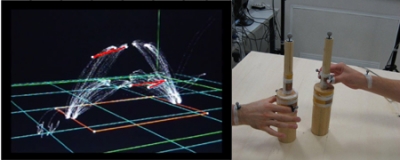Movement kinematics will be recorded by using an ELITE motion analysis system (Bioengineering Technology & Systems [B|T|S]). The ELITE system has been designed for automatic and reliable analysis of body movements based on real-time processing of TV images. The fast processor for shape recognition (FPSR) constitutes the core of the ELITE system. It processes the TV image provided by several simultaneously recording infrared cameras and it uses a dedicated algorithm to: i) recognize markers only if their shape matches a determined mask, ii) compute markers coordinates in 2D space; information are then stored in order to off-line perform cross-correlations between 2D images provided by several infrared cameras; this allows the reconstruction of markers trajectories in 3D space. Afterwards, each marker can be classified on the basis of a suitable model of the body and further data processing can be implemented (i.e., calculation of speed profiles).
Spherical reflective markers are used and fixed on relevant body parts of each participant; their shape allows their image not to change if they rotate on their axes and the reflective material increases the contrast, thus improving the infrared cameras recognition reliability. Previous to data recording, the calibrating procedures allow the ELITE system to be aware of all relative spatial information contained within the working volume (i.e., the space in which the movements will take place). This spacial calibration is performed by recording the position and orientation of all infrared cameras with respect to the laboratory reference system. The standard deviation of the reconstruction error is always inferior to 0.5 mm for the three axes. Our system is constituted by four infrared cameras with wide-angle lens and with a 100 Hz sampling rate. In order to record interaction kinematics, the four cameras will be placed about 100 cm away from each participant and kinematics will be recorded from both participants at the same time. In order to perform dual-subjects kinematic analyses, a custom-made program developed in MatLab (MatLab, The Mathworks Inc.) will allow us to compare the time-patterns of participants’ speed profiles and trajectories of relevant movement parameters (e.g., of the grip aperture during the joint reach-to-grasp task).













